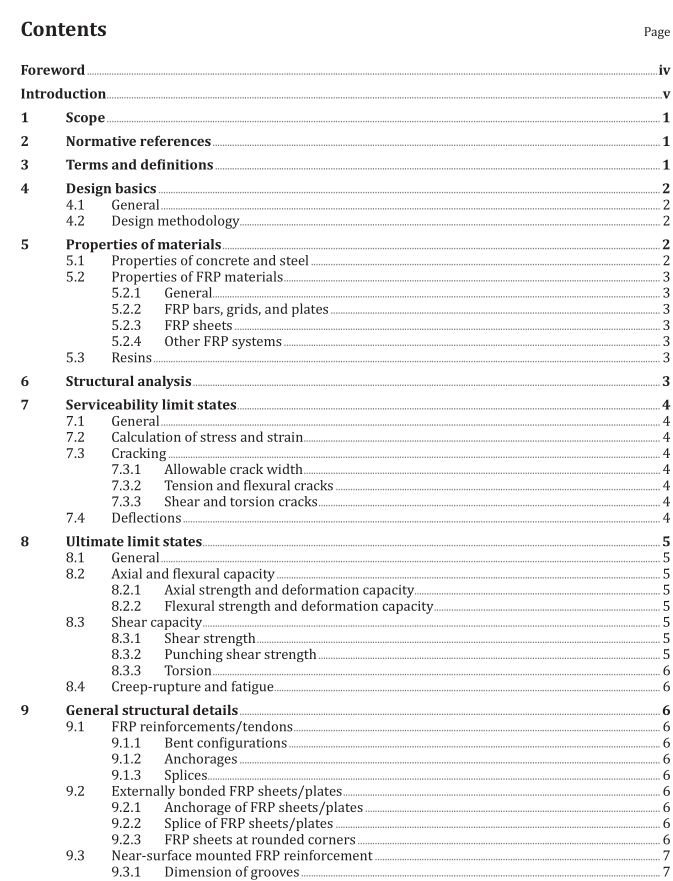ISO 14484 pdf download

ISO 14484 pdf download Performance guidelines for design of concrete structures using fibre- reinforced polymer (FRP) materials
In the case of upgrading existing concrete structures with FRP materials, the strengths of concrete andsteel should be determined with consideration of the in situ conditions, such as measured material andgeometric properties of the existing concrete structures, instead of their material strength values usedin the original design.
5.2Properties of FRP materials
5.2.1General
The FRP materials used for concrete structures should be those whose quality and performancecharacteristics have been confirmed to be compatible with environmental conditions under which thestructure will be exposed.
The characteristics of FRP materials should be defined in general conformance with reliability-baseddesign requirements.
The elastic moduli of FRP materials deviate significantly from that of steel reinforcement depending onthe types of fibre used, such as carbon, aramid, glass or basalt, and the fibre volumetric ratio.
The compressive strength of FRP materials should be generally ignored in design unless specifiedotherwise.
lf necessary, the temperature-sensitive characteristics of FRP materials should be appropriatelyconsidered in design, with attention to its possible strength and stiffness loss at elevated temperatures.An environmental reduction factor should be introduced to account for the environmental effect on thestrength of FRP materials during the expected service life of the structure.
FRP materials shall be designed against creep-rupture under sustained loads unless otherwise noted.FRP materials shall be designed against fatigue under cyclic loading unless otherwise noted.
5.2.2 FRP bars, grids, and plates
Properties of FRP bars, grids, and plates should be determined in accordance with ISO 10406-1.
5.2.3 FRP sheets
Properties of FRP sheets should be determined in accordance with ISO 10406-2.
5.2.4other FRP systems
Properties of other types of FRP systems should be determined based on appropriate test methods,with consideration to their intended applications.
5.3 Resins
Mechanical and physical properties of resins (matrix for fibres and bonding adhesives) should bedetermined in accordance with appropriate standards, such as corresponding IS0 technical standards.
6Structural analysis
Structural analysis of concrete structures with FRP materials should consist of the determination ofstructural response for the examination of limit states such as ultimate limit states and serviceabilitylimit states. In general, structural analysis methodologies specified in IS0 19338 for structural concretewith traditional reinforcing materials may be applied for concrete structures with FRP materials.
Structural analysis of concrete structures with FRP materials should take into account the linear elasticmaterial properties of FRP and the possible debonding failure between the FRP and concrete, which
limit development of ductility in the structure. In general, moment redistribution away from sectionswith FRP materials should not be considered unless otherwise specified.
7Serviceability limit states
7.1General
Serviceability limit states should be verified to ensure the intended performance of concrete structureswith FRP materials under service conditions during their design life.
7.2Calculation of stress and strain
Unless otherwise specified, linear analysis should be used in the computation of stresses and strains inFRP in member sections under service.
Iln the case of upgrading existing concrete structures using FRP materials, the initial stresses in themember sections due to the permanent loads existing before FRP upgrading should be appropriatelyconsidered for analysis.
7.3 Cracking
7.3.1 Allowable crack width
The allowable crack width should be determined based on the intended purpose of the structure,environmental conditions, member conditions, etc.
When determining the allowable crack width, the non-corrosive property of FRP can be taken intoaccount.
7.3.2Tension and flexural cracks
The calculated crack width should be limited as appropriate through detailing the size, spacing andlocation of FRP reinforcement appropriately.
Conventional formulae may be used to calculate the tension and flexural crack width, provided thatthey are modified to take into account the stiffness of the FRPand the bond characteristics between theFRP and concrete.
It may not be necessary to consider the limit for tension and flexural crack width from the viewpoint ofdurability for those concrete structures in which FRP is used as the only reinforcing material.
ln the case of FRP-upgraded concrete structures,crack widths should be checked to ensure that theinternal steel reinforcement is protected against corrosion at service conditions.The upgrading effectsof FRP materials should be taken into account in the calculation.









